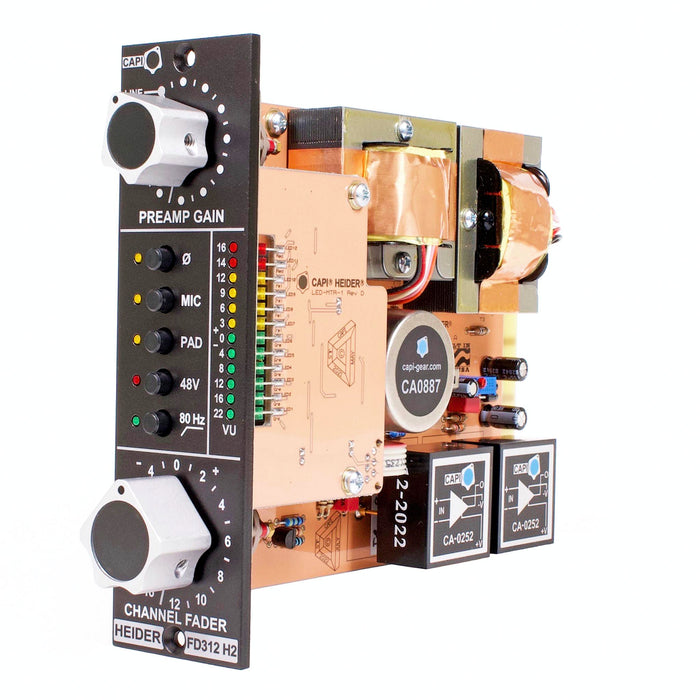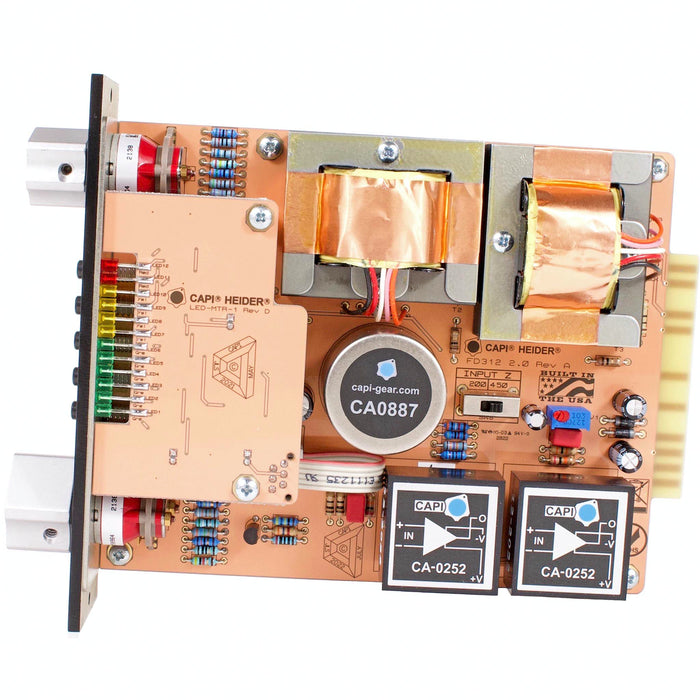
CAPI Heider FD312 H2 500 Series Preamp
After nearly 10 years of existence, the modern classic Heider® FD312 has gotten a
rework! We are pleased to present the Heider® FD312 H2.
Besides the immediately apparent monochrome front panel and controls, here are
the main differences:
- A custom exclusive CAPI version of the RE-0887 input transformer
- A pair of exclusive Litz wire 2503 output transformers
- A pair of our potted CA-0252 discrete opamps
- The impedance load switch was moved to the PCB and its front panel position
replaced with a crowd favorite 80Hz High Pass Filter
- The impedance load switch is default set to 450 ohms and does not affect level
in Line mode
- Phantom power is defeated when Line mode is selected
Sonically all of the changes add up to capturing a more 3D space surrounding the
microphone. It appears more clear than the OG version while also sounding more
analog. Bigger, deeper, sweeter.
The Heider® FD312 H2 is a special and unique preamp module that stands out in
today's crowded 500 series market. The preamp stage has been carefully modeled
after the preamps in the famous Wally Heider Recording Studio 4 console custom
built by Frank DeMedio circa 1972. The original pre's were stock 312 cards modified
by DeMedio. Frank removed the AP2622 input transformer and replaced it with a
custom wound Ed Reichenbach RE-0887. The RE-0887 has a very special tonal
quality with some of the most buttery smooth mids you will ever encounter! This
tone has been retained with our CA-0887.
To enhance this special preamp circuit even further, we chose to employ a stepped
'fader' and active booster stage, very reminiscent of our popular 2-stage VP28
preamp. This is essentially the same booster circuit that was used in the early to
mid '70's vintage API consoles. In remaining true to the Heider® circuit, all AC
coupling capacitors have been removed from the audio path. We don't think
coupling caps are evil, they are just not needed in this particular circuit. This fader
booster stage has 12dB of gain 'in hand', exactly like a real console. This allows for
many different gain combinations. You can crank the fader and reduce the preamp
gain or in contrast, attenuate the 2nd stage and crank the preamp gain for some
sweet, additional harmonic content.
The original Heider/DeMedio preamp cards used stock AP2503 output transformers.
With the desire to have something unique, we are using our 2503-Litz wire outputs.
The very same that we use in our Platinum line of preamps.
In trying to be loyal to the console signal path, both gain stages have a 2503-Litz
output transformer. The first or preamp stage output transformer provides +6dB of
gain, blocks DC from the stepped fader and imparts a little more character into the
overall circuit, as compared to a 'direct' output.
The operational amplifiers are the pure heart of any preamp like the Heider® H2.
We naturally wanted to stay as close as possible to the discrete Studio Systems
opamps from the early '70's. In a current commercially available product, we
strongly believe that our potted CA-0252 opamps are the closest thing alive. Each
Heider® H2 contains two of these glorious discrete blocks of love.
Each and every Heider® FD312 H2 is hand assembled, burned in and tested at
CAPI headquarters in Nashville Tennessee.
Key Operating Features:
In MIC mode, the stepped PREAMP GAIN ranges from +25dB to +60dB, with an
input impedance of 450 ohms.
In LINE mode (MIC pushbutton out or disengaged), the stepped PREAMP GAIN
ranges from -14dB to +21dB, with an input impedance of 9K ohms.
Sliding the PCB mount Input Z switch to '200' when in MIC mode will decrease the
gain by 3dB while decreasing the input impedance to 200 ohms. Since the upper
ten PREAMP GAIN steps are also in 3dB increments, this allows for many creative
tonal combinations.
The PAD pushbutton equates to 16dB of attenuation in either MIC or LINE mode.
With the PAD pushbutton engaged while in MIC mode, the input impedance is 800
ohms.
The stepped CHANNEL FADER switch and 2nd stage booster amp provide a range
of -16dB to +12dB in addition to the above-mentioned preamp gain ranges. This
equates to a maximum gain of 72dB when in MIC mode with the Input Z switch
set to '450' and 69dB when in MIC mode with the Input Z switch set to '200'.
Accurate metering of the final output signal is achieved using LM339 quad
comparators in a 'console' style configuration.
Physically and electronically fully VPR compliant with current draw less than 101mA
per rail (under typical operating conditions)


